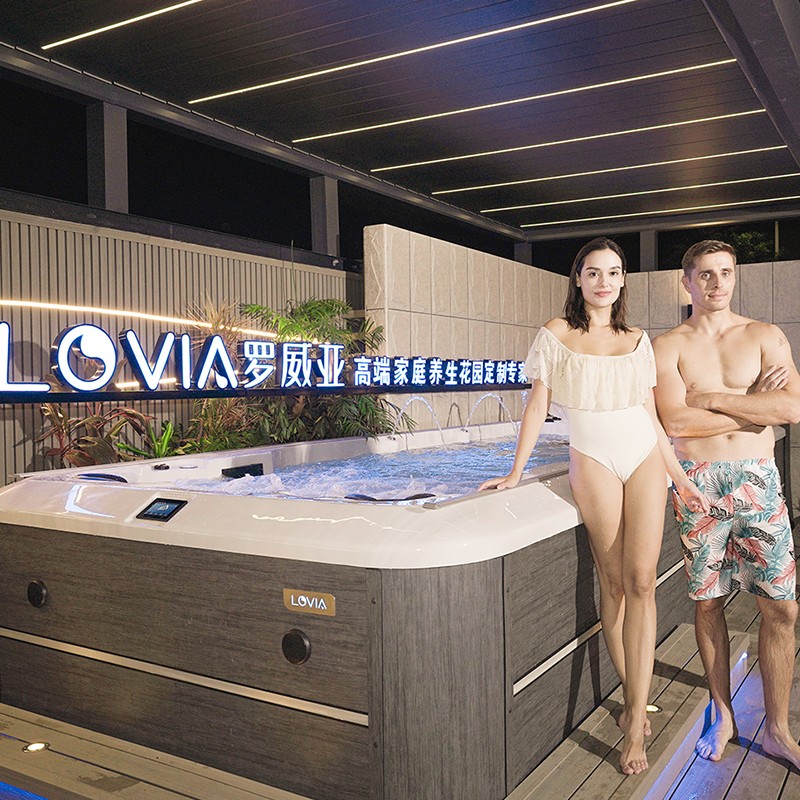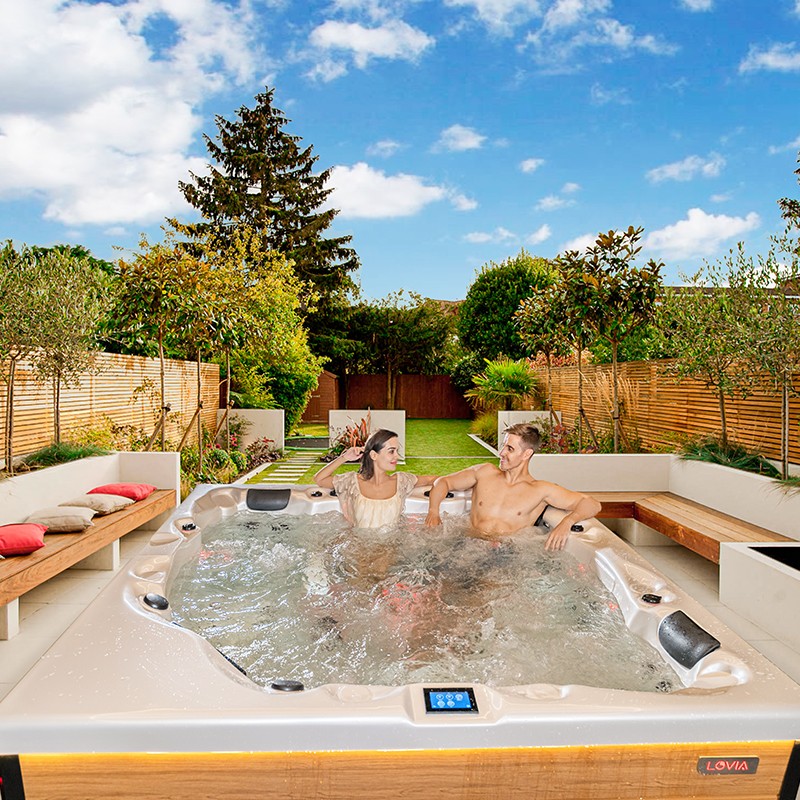
Is it safe to enter a foamy hydromassage bathtub?
2025-11-14 15:35When you turn on your bathroom ambient light and your beloved hydromassage bathtub, only to find a thick layer of foam floating on the surface, your first reaction might be—is this normal? Is it still safe to go in?
This article provides a comprehensive, professional, and logically clear analysis of the core question: "Is it safe to enter a foamy hydromassage bathtub?"

Why does a hydromassage bathtub foam?
There are various reasons why a hydromassage bathtub foams, and understanding the causes is the first step in determining its safety. The main reasons include:
1. Cleaning agent and bath product residue
When using shampoos, shower gels, bubble baths, essential oils, or skincare products, surfactants, oils, and thickeners in these products can remain on your skin and in the water. These substances easily generate foam, especially with water circulation, bubble functions, and the action of the nozzle, where the foam is generated and persists due to agitation.
2. Biofilm or Organic Matter Accumulation in Pipes and Nozzles
Over time, a biofilm may form on the internal pipes, nozzles, and filter of the hydromassage bathtub. This biofilm is composed of sebum, dead skin, shampoo residue, and microorganisms. The biofilm not only reduces system hygiene but can also release foam-producing substances during agitation, causing foaming on the water surface.
3. Water Quality Issues (Organic Matter or Softeners)
Dissolved organic matter, hardness regulators, or certain softening agents in the water can also affect foam formation and stability. Hard water and soft water behave differently in terms of foam—some additives are more likely to foam in soft water.
4. Improper Use of Chemicals
Improper dosage or insufficient mixing of disinfectants, algaecides, or pH adjusters can trigger chemical reactions that produce foam or residue, or react with bath products to generate more foaming components.
5. External Contaminants (Dust, Fibers, etc.)
Clothing fibers, hair, dust, and other solid impurities can be introduced into the water and form stable foam on the surface, especially when vigorously agitated by a circulation system.

Is it safe to enter a foaming hydromassage bathtub?
Short Answer: Not necessarily safe; it depends on the source of the foam and the water quality. Below is a more professional assessment of safety.
1. What are the potential health risks?
• Skin irritation and allergies: If the foam is caused by residues from shampoo, conditioner, or detergents, it may contain fragrances, surfactants, etc., which can cause redness, itching, or contact dermatitis in people with sensitive skin with prolonged contact.
• Respiratory irritation: Very large amounts of foam or foam containing volatile chemicals may release aerosols when agitated, causing irritation in people with asthma or respiratory sensitivities.
• Infection risk: If the foam is caused by biofilms or bacterial/fungal contamination, there is a risk of skin infections, ear or urinary tract infections (especially for people with weakened immune systems).
• Eye irritation: Residual chemicals or bacteria in the foam can irritate the eyes, causing burning sensations or conjunctivitis.
2. What are the problems from an equipment and safety perspective?
• Circulation system blockage and wear: Large amounts of foam and organic residue can enter the filter and pipes, leading to blockages, increased pump load, and shortened equipment lifespan over time.
• Electrical safety risks: If the spa jacuzzi tub water contains a large amount of foam accompanied by floating oil, it may affect the conductivity of the water surface and the normal operation of the controller's sensors (although this impact is small, it is worth noting).
• Cleaning difficulty and hidden contamination: Foam can mask water turbidity or odors, concealing potential problems and delaying maintenance.
3. Conclusive judgment
• If the foam originates from short-term use of bubble bath liquid or a small amount of detergent residue, and the water has no odor or obvious turbidity, the risk is generally low, but it is still recommended to exercise caution when entering the spa jacuzzi tub and drain and clean it as soon as possible.
• If foam is accompanied by an odor, discoloration, a noticeable oil film, or appears in a hydromassage bathtub that has not been cleaned for a long time, it is recommended to stop using it immediately and conduct a thorough inspection and disinfection.

Why do some foams look more "dangerous"?
Not all foams look the same. The following visual and olfactory cues can help determine whether foam may pose a health or equipment risk:
Color and Transparency:
• Pure white or slightly transparent fine foam is common in clean bubble bath liquids or low-concentration surfactants;
• Yellow, gray, or colored foam may contain grease, dirt, or microbial metabolites and should raise suspicion.
Foam Durability:
• Foam that dissipates quickly is often caused by mild surfactants;
• Foam that is stable for a long time and does not dissipate easily usually contains high molecular weight substances, grease, or biofilms, making it more difficult to handle.
Odor:
• A pungent chemical odor may indicate cleaning agents or an improper chemical reaction;
• A putrid or musty smell often indicates biological contamination.
Oil Film or Floating Debris:
• A thin oil film or visible floating debris on the water surface indicates a high level of organic matter or skin-care oils in the water.
What should I do when my spa jacuzzi tub is foaming?
When faced with a foaming hydromassage bathtub, please follow these steps, prioritizing human health and equipment safety.
1. Immediately stop use and disconnect power
If you are still using the tub while it is foaming, first turn off the spa jacuzzi tub's water pump and aeration function, and disconnect the power to prevent the equipment from continuing to circulate in a contaminated state and carrying contaminants deeper into the system.
2. Perform a simple visual and olfactory inspection
Observe the color and odor of the foam and whether it is accompanied by an oil film or floating debris. A noticeable odor or discoloration indicates a high-risk situation.
3. Drain and clean surface debris
Drain the water from the spa jacuzzi tub and use a net or filter cloth to remove floating fibers, hair, and debris. Use disposable gloves to avoid direct contact with the suspected contaminated water.
4. Cleaning and Disinfecting Pipes and Nozzles
For light foaming, rinse the nozzles with warm water and run the circulation for a short time, then drain again.
For suspected biological contamination or persistent foam, use a hydromassage bathtub pipe cleaner or one containing an appropriate amount of disinfectant (refer to the manufacturer's instructions) for deep cleaning. Add the cleaner to the empty tub and run the circulation for 15–30 minutes as recommended, then drain completely and rinse thoroughly with clean water until there is no foam or odor.
Note: Do not mix different chemicals (such as chlorine and acidic descaling agents) to avoid generating harmful gases or chemical reactions.
5. Cleaning the Filter and Removable Parts
Remove and clean the filter cartridge, filter screen, and removable nozzle parts. If necessary, remove the biofilm with a brush, then disinfect, air dry, and reinstall.
6. Test Water Quality, pH, and Disinfectant Concentration
Before refilling and resuming use, use test strips or a water quality tester to test pH, free chlorine/bromine levels, etc., to ensure they are within safe ranges (generally pH 7.2–7.8 is ideal, unless using a different disinfection system; adjust according to the spa jacuzzi tub product manual).
7. Professional Inspection for Severe Cases
If repeated bubbling occurs after multiple cleanings, or if abnormal pump noise, pipe blockage, or persistent odor occurs, contact a spa jacuzzi tub professional service provider for pipe disassembly and inspection, deep disinfection, or component replacement. Persistent biofilm or bacterial colonies require professional disinfection and physical removal.

How can I determine if my hydromassage bathtub has "biofilm contamination"?
Biofilm is a highly insidious problem. The following signs indicate its potential presence:
• Reappearance of foam or odor shortly after rinsing;
• Uneven water flow from the nozzles, black spots or sticky residue around the outlets;
• Frequent appearance of small floating particles on the water surface, or easy regeneration of dirt on the filter surface;
• Skin irritation or recurring infections (ear canal, vulva, etc.).
Once biofilm forms, it is difficult to completely remove with regular rinsing. Specialized cleaning agents and high-temperature or mechanical scrubbing are required. If necessary, replace certain non-removable tubing components.
How to Prevent Hydromassage Bathtub Foaming – Daily Maintenance Checklist
Prevention is always more economical and safer than treatment. Below are detailed maintenance and usage suggestions to help you keep your hydromassage bathtub in a low-foaming, safe state.
1. Before and After Each Use
• After showering: Wash away skincare products, oils, and dirt, reducing the amount of soluble organic matter entering the bathtub.
• Short-time flushing cycle: Run a short cycle and flush after each use to remove residue.
• Avoid bringing clothing or towels into the water: Even tiny fibers can increase the filter's workload and contribute to foaming.
2. Periodic Maintenance (categorized by frequency)
• Weekly: Inspect and clean the spa jacuzzi tub filter and cartridge; wipe the outside of the nozzles; observe water quality and odor.
• Monthly: Perform a deep clean with a pipe cleaner, running for 15–30 minutes followed by a thorough rinse; inspect and clean all removable parts.
• Quarterly: Test pH, disinfectant concentration, and water hardness, adjusting as needed; check the safety of electrical and drainage components.
• Annually: Have a professional perform a system overhaul and deep disinfection, especially for spa jacuzzi tubs used long-term or in tropical humid regions.
3. Usage Recommendations
• Choose low-foaming or dedicated bathtub additives: Low-foaming fragrance products designed for hydromassage bathtubs are available on the market; use them whenever possible.
• Control the amount of skincare oils and essential oils used: If you like to use essential oils in your bathtub, choose water-soluble or specialized products and strictly follow the recommended dosage.
• Avoid unauthorized chemicals entering the system: such as household cleaners, cosmetics, or other industrial chemicals.
Can I use household laundry detergent or dish soap to clean my hydromassage bathtub?
Not recommended. Household laundry detergent and dish soap have strong foaming power, and the residue is difficult to rinse thoroughly, easily leading to continuous foaming and damaging internal pipes and the pump. Use manufacturer-recommended or specialized pipe cleaners and bathtub cleaners.
Can adding a large amount of disinfectant immediately after foam appears solve the problem?
It is not recommended to add a large amount of disinfectant hastily. Blindly adding chemicals may cause chemical reactions, produce irritating gases, or damage the equipment. Drain and clean the tub first, then disinfect and clean it properly according to the spa jacuzzi tub instructions or professional advice.
Does foam necessarily mean excessive bacteria?
Not necessarily. Foam can be caused by sterile surfactants (such as bubble bath liquids), biofilms, or organic matter. A comprehensive assessment is needed, considering the odor, color, persistence, and water quality of the water in the spa jacuzzi tub.
Can children or pregnant women use a foamy hydromassage bathtub?
Not recommended. Children and pregnant women are more sensitive to chemicals and hot water. If the source of the foam is unknown, avoid entering the water until the water quality is confirmed to be safe.
When is it safe to use, and when should use be discontinued?
1. Safe to use
Foaming is short-lived, minimal, and of a known source (recent use of low-foaming bath liquid or a small amount of shampoo/conditioner), the foam has no unusual odor, and the water color is normal. It is recommended to drain the water shortly and continue use after regular cleaning and maintenance.
2. Discontinue use and thoroughly clean the tub
Foam accompanied by an unusual odor, discoloration, oily film, or recurring foam after cleaning, or if the user experiences an abnormal skin reaction. At this point, stop using the spa jacuzzi tub, thoroughly drain, clean, and disinfect it, and have it inspected and repaired by a professional if necessary.
What Components and Brands Are Used in LOVIA SPA Products?
Each LOVIA SPA is built with top-tier components, ensuring performance and longevity. We use American Aristech acrylic for shells, Balboa control systems for precise operation, and LX pumps for energy efficiency. These world-recognized brands help us deliver spa units with superior strength and durability. As a certified manufacturer and supplier, LOVIA SPA also offers customized options, wholesale pricing, and continuous promotions to meet the purchasing demands of global distributors and project developers.
